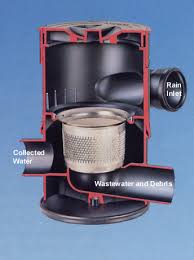 Rural residents are finding that rainwater collection can be a viable alternative to well water. Since rainwater is generally cleaner than surface water and well water, a rainwater system that is properly designed and installed can supply a household with good, clean water for potable use.
Rural residents are finding that rainwater collection can be a viable alternative to well water. Since rainwater is generally cleaner than surface water and well water, a rainwater system that is properly designed and installed can supply a household with good, clean water for potable use.
In a residential setting, the average person uses 30 to 50 gallons per day. For a 2-person household, that would be 3,000 gallons per month. A 2,000 sq ft roof will yield over 44,000 gallons of rainwater with 36 inches of annual rainfall, which is more than enough to supply a residence.
Steel and plastic water tanks are economical to install when considering the cost of a having a drilled well.
 RainBank will be happy to calculate your potential yield of available rainwater from your roof. Contact us using the form below.
RainBank will be happy to calculate your potential yield of available rainwater from your roof. Contact us using the form below.

 Since irrigation and water closets consume the majority of water in commercial buildings, many Seattle businesses and utilities are finding cost savings by installing rainwater collection systems.
Since irrigation and water closets consume the majority of water in commercial buildings, many Seattle businesses and utilities are finding cost savings by installing rainwater collection systems.

 After the first flush device, secondary screening is needed before raw rainwater enters the storage tank or cistern. A fine mesh stainless steel screen should be ordered with your rainwater storage tank. Be sure each tank that is receiving rain from a downspout has a screen. The screen is easily removed for periodic cleaning.
After the first flush device, secondary screening is needed before raw rainwater enters the storage tank or cistern. A fine mesh stainless steel screen should be ordered with your rainwater storage tank. Be sure each tank that is receiving rain from a downspout has a screen. The screen is easily removed for periodic cleaning. A vortex filter for underground transfer from gutter to a sump tank is a good way to remove debris before rainwater is pumped to the cistern. Only periodic cleaning of the vortex filter is needed. Vortex filters should meet the roof size requirements to work effectively and installed per the manufacturer’s recommendations. A vortex filter can be used instead of a first flush device when mounted between the gutter and the cistern.
A vortex filter for underground transfer from gutter to a sump tank is a good way to remove debris before rainwater is pumped to the cistern. Only periodic cleaning of the vortex filter is needed. Vortex filters should meet the roof size requirements to work effectively and installed per the manufacturer’s recommendations. A vortex filter can be used instead of a first flush device when mounted between the gutter and the cistern.